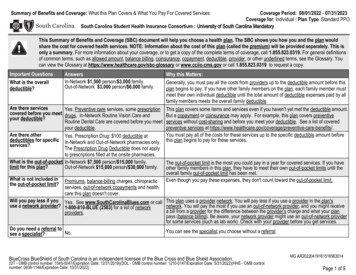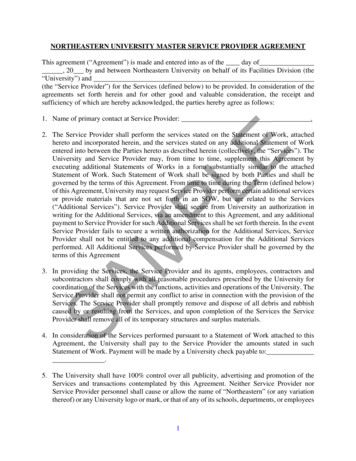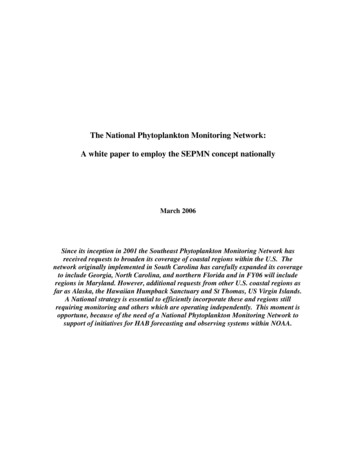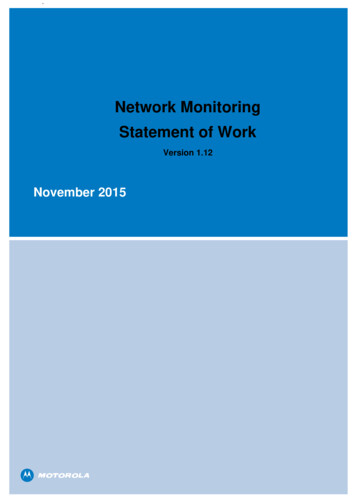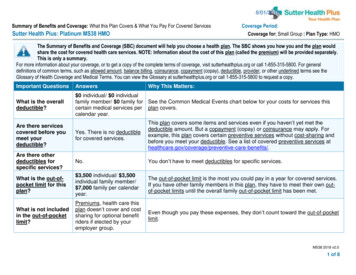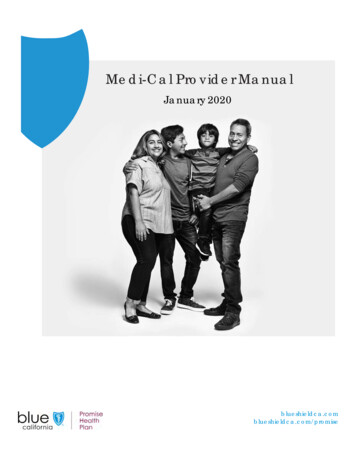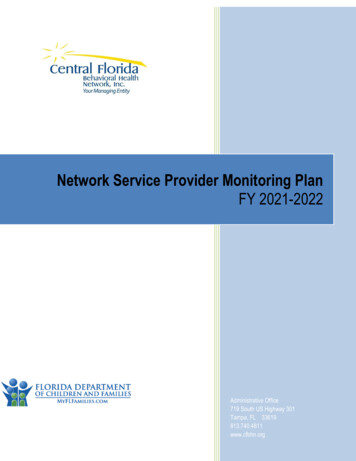
Transcription
Network Service Provider Monitoring PlanFY 2021-2022Administrative Office719 South US Highway 301Tampa, FL 33619813.740.4811www.cfbhn.org
The Network Service Provider Monitoring Plan (NSPMP) documents the multi-faceted approach utilized by theCentral Florida Behavioral Health Network (CFBHN) to monitor Network Service Provider (NSP) performance.CFBHN’s administrative, programmatic and financial monitoring procedures rely on: The use of a Continuous Quality Improvement (CQI) monitoring team; Completion of financial, administrative, program and service validation tools; Established performance measures and benchmarks; and A formal NSP Scorecard.Required elements of this plan are addressed on the pages that follow. This plan is reviewed on an annual basis inaccordance with requirements of the Department of Children and Families (DCF), to ensure that CFBHN’s policiesand procedures are current, and that compliance with federal and state requirements is maintained.1.1 Completion of Risk Assessment to Develop an Annual Monitoring ScheduleOn an annual basis, CFBHN completes a formal assessment that outlines the level of risk anticipated in thecoming year for each NSP. The assessment summarizes risk by assigning a point value to several criteria uponwhich each provider is scored. These include: The total amount of funding awarded to the NSP in the new year;The addition, or loss, of funded program services;Accreditation status;Recent or upcoming changes in leadership to the NSP’s Chief Executive Officer, Chief Financial Officer, orChief Operations Officer positions;CQI monitoring results obtained in the previous year, including corrective actions issued by the Contracts,Network Development Community Services (NDCS), and/or Risk Management departments; andFinancial concerns identified by CFBHN, including formal findings identified in the organization’sindependent audit.The total score obtained by each NSP is calculated and ranked among others funded by the Network. Statisticalanalysis is then used to identify the agencies that present an average, above average, or below average level ofrisk. The risk assessment helps CFBHN staff to identify organizations in need of attention, and is taken intoconsideration in determining the depth and/or timeframe of monitoring to be completed in the new fiscal year.A copy of the risk assessment tool completed at the start of FY 2021-2022 is included in Appendix A.1.2 Statistically-Valid Sampling Methodology to Ensure On-Site Monitoring by the Managing EntitySample size is determined by the type of monitoring conducted for a particular organization. FULL monitoringsinclude a random sample of ten files per program area tool. LIMITED monitorings review a random sample ofseven files. If a program deficiency or inconsistency is identified as a result of the review of the pulled sample,additional files may be requested for review by the CQI team.FULL and LIMITED monitorings also include service validation. Service validation requires a review of thebackup documentation associated with services billed to CFBHN during the current fiscal year. This type ofreview looks at a statistically-significant number of services and/or events based on the NSP’s service volume.Service validation samples are calculated using a confidence level of 95%, and a confidence interval of 5%. Thismeans that CFBHN can be 95% sure that an NSP’s actual service validation percentage falls /- 5%.of the scorethey achieve. For the majority of providers monitored by the CQI team, this equates to a sample size of 200-400services. If a service validation discrepancy is noted, the number selected in the service validation sample for aparticular program or agency may be increased.Annual CFBHN Review/Update: 7/26/2021Submitted to DCF: 7/30/2021, 8/17/2021Page 1
1.2.1. Accredited Organizations, Completed at Least Once Every Three YearsIn accordance with 402.7306 F.S., NSPs in good standing with CFBHN and accredited by the JointCommission, Commission on Accreditation of Rehabilitation Facilities (CARF), The Council On Accreditation(COA) or other recognized accreditation organization receive a FULL, comprehensive on-site monitoringonce every three years. A FULL monitoring includes a review of contract and administrative compliance,completion of program monitoring tools, and validation of service billing and back-up documentation. Acomprehensive BASELINE monitoring is completed during the first year that an accredited NSP is funded byCFBHN. COALITION monitorings are those completed exclusively with NSPs that are county preventioncoalitions.A LIMITED review process is utilized for accredited NSPs during the other two years of the three-year cycle.LIMITED reviews include an attestation that the provider is following contract, state, and federal guidelinesas required, but includes a review of federal Block Grant funded programs, programs that call for ongoingservice validation, and/or that are newly-funded. This allows the CQI department to check in with theorganization, answer questions, and provide technical assistance, but limits the extent of the monitoring thattakes place. This process also guarantees that the CQI department has contact with 100% of subcontractedNSPs at least once during each fiscal year1.2.2. Unaccredited Organizations (Including Residential or Inpatient Services), Completed AnnuallyCFBHN is accredited as a Network through CARF. This accreditation requires CFBHN to monitorunaccredited NSPs that provide direct network services on an annual basis. Proviso programs, regardlessof accreditation status, are also monitored annually.1.2.3. Unaccredited Organizations (No Direct Service), Completed Bi-AnnuallyNSPs that are unaccredited, and that do not provide direct service to clients, are monitored every two yearsby the CQI department. County prevention coalitions fall into this category, and are exempted from review ina given year if the previous year’s monitoring did not result in a Corrective Action.1.3. On-Site Monitoring and Desk ReviewsThe annual monitoring schedule is developed by the CQI team at the start of each fiscal year. It is distributed toNSPs and submitted to DCF as required by contract on or before July 31st. All dates are considered tentativeuntil confirmed with each organization. The schedule is also posted onto the CFBHN SharePoint system, andupdated on an ongoing basis, as needed, according to staff or NSP needs. In addition to the dates of themonitoring, the schedule indicates if the review will be FULL, LIMITED, COALITION, BASELINE or EXEMPT,and if it will be completed on-site or via a desk review.For fiscal year 2021-2022, an On-Site monitoring is required if the NSP: Is scheduled for a BASELINE or FULL monitoring; Is currently on a DCF Oversight Plan managed by CFBHN; Has been cited by another CFBHN department for concerns related to performance. Requests that an on-site review be completed.An NSP is eligible to for a Desk review if each of the following criteria are met: The NSP is scheduled for a LIMITED monitoring; or The NSP does not meet any of the ‘On-Site’ requirements listed above.When scheduled for a Desk review, NSPs are permitted to select from one of three methods to share data with theCFBHN monitoring team:1. Required documentation can be uploaded into SharePoint, CFBHN’s secure, electronic vault platform.Annual CFBHN Review/Update: 7/26/2021Submitted to DCF: 7/30/2021, 8/17/2021Page 2
2. A video conference can be set up via MS Teams to allow the monitoring team to view requireddocumentation.3. NSPs that utilize an electronic health record (EHR) may provide monitoring team members withtemporary, limited access to the system to review required documentation.In FY 21-22, CFBHN anticipates that on-site reviews will resume. However, this decision will be made inconsideration of the guidance of the Centers for Disease Control and state health officials.See Appendix B for a copy of the monitoring schedule for FY 21-22.1.4. Policies, Procedures and Tools for General Contract MonitoringCFBHN maintains established policies and procedures that direct staff on the monitoring of NSPs. In addition tothe policies and procedures, CFBHN has a Quality Assurance/ Continuous Quality Improvement Plan in placethat outlines specific practices followed by the CQI program.1.4.1. Fiscal StabilityCFBHN’s Finance Department conducts an annual financial risk assessment of NSPs. This assessment isbased on the information received from the organization’s independent audit or other relevant financialsource. If an NSP is not subject to an audit according to 2 C.F.R 200.0-.521 Uniform AdministrativeRequirements, Cost Principles, and Audit requirements for Federal Awards, CFBHN uses the provider’sinternal financial statements to conduct the financial risk assessment.Utilizing the CFBHN Financial Risk Assessment Tool, a score that represents the organization’s financialhealth is obtained for each NSP. A provider’s score places them into one of three categoriesA) No Action RequiredB) Moderate Action requiredC) High RiskIf an NSP’s score falls in the ‘No Action Required’ category, CFBHN records the information for future trendanalysis. If their score falls in the ‘Moderate Action’ category, CFBHN utilizes the NSP’s quarterly financialsand the Financial Risk Assessment to perform additional risk analysis. CFBHN then reviews those scores toidentify any trends that may indicate the need to further review results with the NSP, or to move them to a newrisk category.If an NSP’s score falls in the ’High Risk’ category, CFBHN: Contacts the provider to have them submit monthly Board minutes that include documentation of the reviewof financials. CFBHN reviews the minutes to verify that the NSP’s Board is being kept apprised of theirfinancial status. Utilizes the NSP’s monthly financials to perform additional risk analysis. Based upon the results, CFBHNestablishes formal benchmarks related to the financial health of the organization. The agency’s CEO andBoard Chairs are invited to take part in these discussions. New benchmarks are added as to the NSP’scontract as additional deliverables. If the deliverables are not met, CFBHN’s Sanctions and PenaltiesEnactment policy is applied. Notifies CFBHN’s Board Executive Committee to make them aware of NSPs that have been determined tobe high-risk.1.4.2. RecordsAs a component of network service provider monitoring, CFBHN’s CQI team ensures that NSPs havepolicies in place that require: (a) Compliance with applicable regulations regarding client protected healthAnnual CFBHN Review/Update: 7/26/2021Submitted to DCF: 7/30/2021, 8/17/2021Page 3
information (PHI); (b) Staff training on HIPAA regulations and the management of PHI; and (c) Retention ofclient records for at least seven years after the date of last entry.It is also the policy of CFBHN to maintain a record retention system that meets all legal, contractual, andregulatory requirements. CFBHN’s Information Technology (IT) systems utilize a procedure to back-up alldata files. Data records are maintained in fire-resistant, locked storage at CFBHN or another securelocation. CFBHN maintains contracts and agreements with vendors to ensure that those that house andstore records do so in a manner that is safe, secure, and HIPAA-compliant.1.4.3 Corrective Action Plan ReviewUpon the identification of formal Corrective Actions, Areas of Concern or Performance Improvementrequests, NSPs are required to submit a written Action Plan to CFBHN describing how they will address andcorrect the issue. Action Plans may be requested in response to non-compliance with any contract, financeand/or programmatic issue identified by the Finance, Contract, CQI or NDCS departments within CFBHN.The Action Plan is due to CFBHN two weeks to 30 days of the initial notice of the deficiency. (Due datesare established by each department, and in consideration of the concern to be addressed.)After Action Plans are reviewed and approved, subsequent follow-up visits or desk reviews are conductedwithin 90 days of the plan’s completion date. Results are reported to the NSP within two weeks ofcompletion of that assessment. The Action Plan is complete when the NSP attains satisfactory scores atfollow-up, or meets other agreed-upon measures demonstrating correction and compliance with theapplicable standard(s). The policies of CFBHN further allow for the consideration of financial penalties andor sanctions if the Corrective Actions are not resolved or continue to occur.1.4.4 AuditsAs noted in section 1.4.1, CFBHN conducts an annual fiscal monitoring of NSPs’ audited financialstatements. This includes a review of the financial statements against a pre-established checklist of statecontract requirements to verify that all elements are present. A copy of the checklist is retained with theNSP’s financial statement.1.4.5 Accounting SystemCFBHN’s accounting practices are reviewed annually to ensure that all state and federal guidelines are met.State supplemental schedules, actual revenue and expenditure reports that identify the NSPs’ ability toreflect, record, and recognize revenues and expenses by funding type, program, and covered service arealso reviewed by the Finance department.1.4.6. InsuranceCFBHN requires NSPs to submit insurance certificates annually to ensure policies meet the contractualrequirements, and that amount of coverage is adequate for the organization.1.4.7. SponsorshipIt is the policy of CFBHN to comply with the Department of Children and Families requirement on the use ofstate funds in publicizing, advertising, or describing the sponsorship of a program that is financed wholly orin part by state funds (Section 286.25, F.S.). CFBHN ensures all contracts include this provision.1.4.8. PublicityAs required by contract Risk Management guidelines, NSPs are required to inform CFBHN of any incidentevent expected to generate media coverage or public reactions to which DCF may be asked to respond orprovide comment. Incidents of this type are brought to the attention of the Department within the guidelinesestablished by reporting procedures CFOP 215-6 and ROP 215-4.Annual CFBHN Review/Update: 7/26/2021Submitted to DCF: 7/30/2021, 8/17/2021Page 4
1.4.9. LobbyingCFBHN complies with the DCF prohibition on the use of contract funds to lobby the legislature, judicialbranch or other state agency. Contracts established between CFBHN and its NSPs also include thisprovision, barring its practice, and all NSPs sign the Certification Regarding Lobbying form (DCF form CF1123) on an annual basis.1.4.10. Client Risk and Incident ReportingIn accordance with DCF requirements, CFBHN’s NSPs submit critical incident reports to the network’s RiskManagement department by phone or electronically through the RL6 incident report management system.Risk Management staff members collect the reports and, as necessary, request additional information fromthe NSPs. Incident data is then transmitted to DCF within the timeframes outlined in CFOP 215-6 and ROP215-4.A multi-disciplinary team of CFBHN staff members review each incident reported to CFBHN to determine ifadditional follow-up is required. When a more in-depth review of the incident’s circumstances is called for,CFBHN may request additional information from the NSP, conduct a site visit, or perform a formal file reviewof the client record. File reviews are typically conducted when an incident involves an individual’s death or aserious injury that occurred while in the care of the NSP. Formal observations identified over the course ofa file review are documented, shared with the provider and tracked over the course of each fiscal year.NSP incident report data is tracked and reported on an ongoing basis by CFBHN. Incident reportingguidelines are reviewed with NSPs via a formal training offered at the start of each fiscal year.1.4.11. Intellectual Property RightsCFBHN complies with the DCF requirement concerning intellectual property, inventions, written orelectronically-created materials, including presentations, films or other copyrightable materials as stated bycontract. Through their subcontracts, NSPs agree not to claim interest in the intellectual property rights ofCFBHN and/or the Department.1.4.12. Data SecurityCFBHN maintains privacy policies and procedures to ensure adherence to data security requirements ofHIPAA and 42 CFR, Part 2. The Network utilizes off-site data storage and access portals to preventunauthorized access to data systems. CFBHN I.T. staff review security logs daily to identify dataabnormalities and/or attempts to inappropriately access network systems. The Network maintains multiplelayers of technology security, including the use of system penetration testing.As a component of its monitoring of NSPs, CFBHN’s CQI team verifies that the NSP maintains policies andprocedures related to data security. The team also ensures that the NSP has formally designated anindividual to serve as the HIPAA Security Officer.CFBHN’s I.T. department requires that DCF HIPAA and Security Awareness trainings be completed by NSPstaff before access to network data systems is granted. Access is revoked for individuals that do not followpassword protection or other data security requirements, and they are required to retake SecurityAwareness training to reinstate their access to CFBHN data systems.NSPs are also required to promptly notify CFBHN when staff leave the organization, so that their systemaccess can be eliminated. Adherence to this requirement is monitored by the CFBHN CQI team.Annual CFBHN Review/Update: 7/26/2021Submitted to DCF: 7/30/2021, 8/17/2021Page 5
1.4.13. Confidentiality of Client InformationAs a component of its monitoring of NSPs, CFBHN’s CQI team verifies that the NSP maintains policies andprocedures related to the protection of client health information, including permitted uses of PHI,safeguarding PHI, authorized PHI disclosures and breach notification procedures. The team also ensuresthat the organization has formally designated an individual to serve as the HIPAA Privacy Officer, staff arereceiving HIPAA training during their orientation and at regular intervals thereafter, and that clients havereceived and signed copies of an NSP’s Notice of Privacy Practices.In addition to its own established policies and procedures related to client confidentiality, HIPAA and 42CFR Part 2, CFBHN utilizes the SharePoint site to provide a secure environment to share client and othersensitive information with NSPs and vice versa. Through its Risk Management department, CFBHNreviews all internal incidents that involve an NSP’s unsecured exchange of individual identifiers or protectedhealth information (PHI), provides technical assistance and guidance to the agency staff in response to theevent, and makes the determination as to whether or not additional notifications to DCF, or other regulatorybodies, may be required.1.4.14 Assignments and SubcontractorsThe Contracts and CQI departments utilize multi-member teams to monitor contract performance, and NSPsare assigned one ‘lead’ staff member from each department to serve as their primary point of contactthroughout the fiscal year. The Contracts department’s list of lead assignments is posted onto SharePoint.NSPs receive notice of their assigned CQI lead on or before July 31st when the monitoring schedule isreleased. Updates to ‘lead’ staff members are communicated to NSPs, as necessary by both CFBHNdepartments.1.4.15 Grievance ProceduresAs part of its monitoring review of NSPs, CFBHN’s CQI department verifies that the following elements arein place at each agency: The NSP has an established grievance procedure; Information on the CFBHN complaint process is posted in plain view in common areas utilized byindividuals receiving services; For funded NSPs with a Crisis Stabilization Unit (CSU) and substance abuse treatment facilities, theYour Rights While Receiving Mental Health Services form, which includes phone numbers for theFlorida Abuse registry and Disability Rights Florida, is posted in common areas as required by statuteand administrative code.CFBHN’s Complaint & Grievance policy outlines the procedures utilized by the network to review andaddress complaints and/or grievances made by individuals receiving services or their family members.Although any CFBHN staff member may be called upon to help resolve a grievance or complaint, membersof the Network Development and Clinical Services (NDCS) team are primarily responsible for this activity.In conjunction with CFBHN’s own accreditation, summaries of consumer complaints and grievances arecompiled and reported to the CQI Oversight Committee on a monthly basis. An annual analysis is alsocompleted to identify trends, areas in need of performance improvement, and actions taken to addressthose issues.Annual CFBHN Review/Update: 7/26/2021Submitted to DCF: 7/30/2021, 8/17/2021Page 6
1.5. Policies, Procedures and Tools for Program Monitoring1.5.1. Scope of ServiceOn an annual basis, NSPs must submit formal program descriptions for review and approval by CFBHN.The descriptions outline the key components of the services funded by the Network, including: A description of the services to be provided; The community’s need for the CFBHN-funded service; The target population(s) to be served; Information on evidence-based and best practices utilized as part of the program; and How individuals and/or families will access the services.This scope of service serves as the basis upon which standards of NSP performance are assessed by theCFBHN Contracts, CQI, Finance and NDCS departments.1.5.2. Service TasksOn an annual basis, monitoring tools are developed for each specific type of program, or program area,funded by CFBHN. Each monitoring tool is reviewed and approved by DCF at the start of each fiscal year.Service tasks specific to each program, and required by a guidance document, program handbook, or law,are typically included as part of the tool utilized by the CQI team to assess NSP performance.Documentation of other administrative or program service tasks may also be requested and maintained byNDCS, Finance and/or Contracts departments.1.5.3. Staffing RequirementsPrograms that require a certain level of staffing, staffing pattern, or the hiring of personnel with specificlevels of experience or education are tracked on an ongoing basis by their CFBHN Program Managers.Adherence to staffing requirements reviewed by the CQI department is captured on the formal tooldeveloped and approved for that program by DCF.1.5.4. DeliverablesThe Contracts department provides administrative and contract oversight of services and deliverables.Deliverables are defined and outlined in the master contract between DCF and CFBHN, and in thesubcontracts between CFBHN and NSPs.1.5.5. Data ValidationSeveral CFBHN departments are involved in the process of data validation:The Finance and Contract departments reconcile NSP invoices with the approved covered services andprograms identified in the Contract and Finance Exchange (CAFÉ).The invoice validation process utilizes data submitted by NSPs into the Central Florida Health Data System(CFHDS) and Service and Finance Exchange (SaFE). NSP data is permitted into the system after goingthrough an edit process to ensure that it meets all the state reporting requirements. To assist NSPs, reportsare available that allow them to review, correct errors, and resubmit data as necessary.This validation includes a review of billing accuracy. Payment is withheld for units that cannot be validated,though providers are given the opportunity to address identified issues and re-submit corrected data thefollowing month for payment. For program established with alternate payment methodologies (CAT, FIT,FACT, Crisis Stabilization, Detox), the Contracts department verifies that applicable service data wassubmitted in the prior month.Annual CFBHN Review/Update: 7/26/2021Submitted to DCF: 7/30/2021, 8/17/2021Page 7
The NSP’s fund utilization is tracked on the Subcontractor Status report on a monthly basis. As the fiscalyear comes to an end, the Finance and Contract departments coordinate with NSPs to pull reported lapsefunding and give it to others who are overproducing in the same program and/or OCA.The CFBHN CQI department contributes to the validation process by reviewing back-up documentationmaintained by NSPs. A random sample of the data entered into the data system is selected for reviewduring a monitoring visit. The statistically-significant size of the sample is determined by the volume of theagency’s services delivered during the prior fiscal year. During the monitoring review, if a service validationdiscrepancy is noted, the number of items looked at as part the review may be increased. NSPs arerequired to back out, or return payment on, data that cannot be validated.Reports produced by the CFBHN IT department include demographic information, the number of individualsserved by programs, outcomes, attainment of performance measures, and dollars utilized. The data formsthe basis of the monthly Benchmark Reports. A help desk ticket system is in place to allow NSPs to requestassistance in resolving data errors.Program Managers working within CFBHN’s NDCS department work closely with NSPs to validate thequality and accuracy of the data submitted to the Network. In FY 21-22, as a result of a finding of the DCFContract Oversight Unit (COU), Program Managers will implement a formal process to monitor anddocument the data validation that they complete with each NSP. This includes program service data, andthe data utilized by NSPs on self-report measures. Steps to be taken, and the timeline for each task, arelisted below:Task1. CQI Director will meet with each Program Manager to formalize and document theprocedure utilized to validate Network Service Provider (NSP) program datareported to CFBHN, including self-report measures.Success Indicator: Meetings with Program Managers have been completed.2. A formal tool will be created for each CFBHN program, allowing ProgramManagers to document the data validation process they complete with each NSP.Success Indicator: Tools utilized to document the data validation process for eachprogram have been developed.3. Procedures that outline the data validation process completed by ProgramManagers will be documented. This will include timelines and due dates put intoplace to guide the program data validation in FY 21-22.Success Indicators: (1) Procedure to be followed by each Program Manager tocomplete data validation process is documented. (2) Annual timeline for completionof the data validation process has been finalized and documented.4. Completed tools that summarize the program data validation process, collectedover the course of the fiscal year, will be made available to DCF for review.Success Indicator: Program data validation tools have been completed by ProgramManagersPersonResponsibleCompletionDateCQI Director10/15/2021CQI 11/30/2021ProgramManagers06/30/20221.5.6. Performance SpecificationsThe Contracts department provides administrative oversight of performance specifications through thepreparation of an annual subcontract with each NSP. The contract is the foundation of accountability forNSP performance, and is the reference document for the NSP and CFBHN related to outcomes, tasks, andresponsibilities.The contract includes attachments that define: the specific populations to receive services; statute andinsurance requirements; requirements for invoice submission and reports; and required performanceAnnual CFBHN Review/Update: 7/26/2021Submitted to DCF: 7/30/2021, 8/17/2021Page 8
outcomes and outputs. It also lists reference documentation for approved covered services, GuidanceDocuments, Templates, unit rates, and total funds awarded.NSPs agree to maintain any required licenses or certifications, to comply with federal and staterequirements, and adhere to minimum staffing qualifications, including employee background checks. Theyalso submit documents to the Contracts department to verify civil rights compliance, proof of currentaccreditation, liability insurance, and nonprofit status and, if applicable, the current sliding fee scale. Theseand other items are collected annually, or as they expire, and kept on SharePoint in the NSP’s Exhibit Adepository.1.5.7. Network Service Provider ResponsibilitiesThe Contracts department executes agreements with each NSP that define its responsibilities related toadministrative compliance, contract responsibilities and performance measures. Subcontracts executedwith NSPs include the required provisions outlined in the Exhibit C – Task List, and updated by DCF on anannual basis. Service and audit documentation requirements are also outlined in the Schedule of CoveredServices (65E-14.021 F.A.C.) and related Guidance Documents issued by DCF.In accordance with payment guidelines established by the Department, NSPs are not permitted to billCFBHN for services rendered to individuals on Medicaid, or who have third party insurance, when thoseservices are paid for by that plan.New responsibilities, or those which are no longer required, are reviewed with NSPs at the start of eachfiscal year through formal webinars or trainings offered by CFBHN’s department or program managers.The Contract department reviews the Scorecard for compliance with performance measures on a monthlybasis. If non-compliance results in the request for a Corrective Action Plan (CAP) or PerformanceImprovement Plan (PIP), NSPs are asked to submit their plans to their contract specialist within two weeksof the request. CAPs and PIPs are submitted to the appropriate CFBHN staff for review and approval. TheContracts department monitors ongoing performance for improvement and potential closure of the PIP/CAP.At
Network Service Provider Monitoring Plan FY 2021-2022. Annual CFBHN Review/Update: 7/26/2021 Page 1 . A formal NSP Scorecard. . programs that call for ongoing service validation, and/or that are newly-funded. This allows the CQI department to check in with the organization, answer questions, and provide technical assistance, but limits the .

